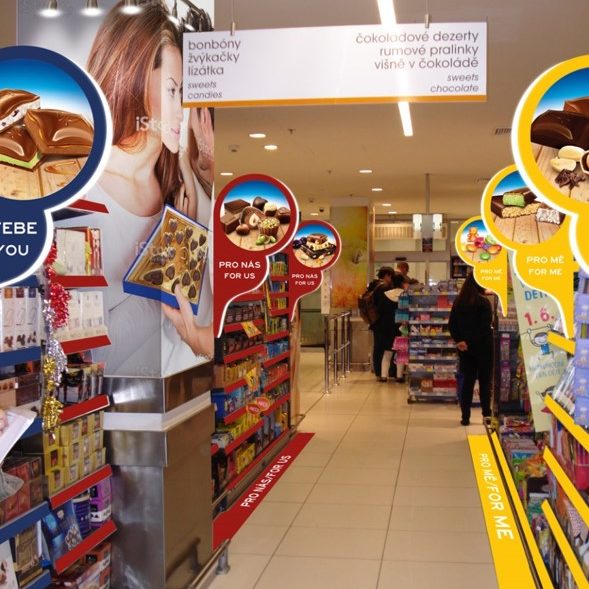Shop in shop Nikon – Alza
]
New project – Nikon Shop-in-shop in Alza Our company DAGO introduces a new realisation of a sophisticated NIKON shop-in-shop, which we have produced and installed in…
Sales promo in hobby markets
There is no doubt that POS can be adapted also to products out of the traditional FMCG – after all, we see the support for telco, automotive or financial services. But how to present attractively drills, saws, grinders and…
New corporate strategy
]
At the conference of our company, we have presented the new corporate strategy for the 5 following years. Its basis is especially increasing the corporate know-how in…
FRAGRANCES
The company Dago is currently coming with many innovations that enhance existing range of products, so we can offer to our clients a much wider application of their ideas and opportunities, what types of POP material place…
Electrotechnical innovations
]
We have launched functional and affordable electro-technical and electronic parts, which can be integrated into traditional POP means, into the market.
We talk about…
Nestlé case study: reflecting the buying behaviour is the key opportunity of the confectionery category growth.

Confectionery is a fixed star in shopping carts, but its producers have faced an important challenge in recent years: How to ensure a long-term and especially healthy growth for this category? In recent years, its sales have increased very slowly, while proportion of products sold in promotions increases every year.
The category team of the company Nestlé has therefore set an ambitious goal to make this category more attractive to customers and to convince them to purchase. ”We knew from our researches that the biggest problem was to motivate shoppers to enter the confectionery aisle. Even though that only every tenth customer walks through this aisle, this part of a store is still the most important place for us in terms of sales volumes. As there is the highest degree of interaction with products and sales conversions, thus percentage of people going past a sales point and shopping,” explains David Wurst, Nestlé confectionery development specialist, and adds that there are different reasons why people do not visit a confectionery aisle.
The category of confectionery is often being positioned outside the natural customer path through a store and so shoppers do not actually get to aisles with confectionery, which is largely purchased based on impulsive decisions. Or else, customers already purchased in secondary locations, where they usually get not only a good price but also do not have to make difficult decisions about what to buy. Some shoppers avoid the confectionery aisles for its “unhealthy reputation”.
These findings were so interesting for Nestlé, that the company decided to explore more deeply the motives, purchasing missions and, in general, the entire decision making process of confectionery customers. After the detailed data analysis they found out that the current product segmentation by product attributes do not match, how current shoppers make their decisions: “In contrast to the prevailing habits in our segment, we have found that the primary factor of the decision making when shopping is the opportunity to consume,” specifies David Wurst. Based on qualitative research, we then identified three basic consumer opportunities – individual consumption, gift and family shopping.
This whole new concept was tested by Nestlé in several modern type stores, where, in addition to new allocation of products, they developed also a navigation P.O.P. media in co-operation with us. These had to be sufficiently attractive, innovative and stimulating curiosity and interest of customers. The main goal was to make subcategories according to consumption opportunities “for me”, “for you” and “for us”. The space of confectionery aisle is not large and the realization conditions brought many restrictions. Shelf assemblies can´t be changes, it is not possible to place P.O.P. materials above them and likewise. Therefore, we have proposed, together with the client, to use stoppers as a main communication means in a store attached directly on the shelfs. In addition to their overall visual attractiveness, their advantage is also the dominance and contrast acting on passing customers. The stoppers are luminous and their communication content can be changed. In addition to stoppers, also floor stickers and colour price bars draw attention to categories. Everything is then harmonized in colours according to particular subcategories for maximum clarity and good customer orientation. The result is a clearer navigation for shoppers, who faced to three main categories instead of the previous six categories when they enter the aisle. The new segmentation of this category also better meets the needs and decision making preferences of customers.
Their responses after the change were positive in 60 %, sales in the category increased by 5 % compared to the previous years. Good results were confirmed also by comparing with controlling stores over the same period. “We are happy with the results of changing navigation on the occasion. Nowadays, this solution is being used in 10 stores in the Czech Republic and Slovakia and we are negotiating about other installations. This project has unambiguously shown that working with shopper insights and researches is meaningful and leads to solutions that are beneficial both in terms of business and mainly from the perspective of better customer experience,” concluded David Wurst from Nestlé.
Members of the realization team:
David Wurst, Category Specialist Confectionery, Nestlé
Jakub Krupička, Channel Development Specialist, Nestlé
Marek Končitík, Supervisor, Dago
Tomáš Žáček, Project manager, Dago
Milan Marek, 3D Designer, Dago
Your DAGO team

 SK
SK


